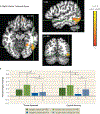Age Differences in the Neural Correlates of Anxiety Disorders: An fMRI Study of Response to Learned Threat
- PMID: 32252541
- PMCID: PMC9078083
- DOI: 10.1176/appi.ajp.2019.19060650
Age Differences in the Neural Correlates of Anxiety Disorders: An fMRI Study of Response to Learned Threat
Abstract
Objective: Although both pediatric and adult patients with anxiety disorders exhibit similar neural responding to threats, age-related differences have been found in some functional MRI (fMRI) studies. To reconcile disparate findings, the authors compared brain function in youths and adults with and without anxiety disorders while rating fear and memory of ambiguous threats.
Methods: Two hundred medication-free individuals ages 8-50 were assessed, including 93 participants with an anxiety disorder. Participants underwent discriminative threat conditioning and extinction in the clinic. Approximately 3 weeks later, they completed an fMRI paradigm involving extinction recall, in which they rated their levels of fear evoked by, and their explicit memory for, morph stimuli with varying degrees of similarity to the extinguished threat cues.
Results: Age moderated two sets of anxiety disorder findings. First, as age increased, healthy subjects compared with participants with anxiety disorders exhibited greater amygdala-ventromedial prefrontal cortex (vmPFC) connectivity when processing threat-related cues. Second, age moderated diagnostic differences in activation in ways that varied with attention and brain regions. When rating fear, activation in the vmPFC differed between the anxiety and healthy groups at relatively older ages. In contrast, when rating memory for task stimuli, activation in the inferior temporal cortex differed between the anxiety and healthy groups at relatively younger ages.
Conclusions: In contrast to previous studies that demonstrated age-related similarities in the biological correlates of anxiety disorders, this study identified age differences. These findings may reflect this study's focus on relatively late-maturing psychological processes, particularly the appraisal and explicit memory of ambiguous threat, and inform neurodevelopmental perspectives on anxiety.
Keywords: Age; Anxiety Disorders; Neural Correlates; fMRI.
Figures




Comment in
-
Developmental Differences in Neural Responding to Threat and Safety: Implications for Treating Youths With Anxiety.Am J Psychiatry. 2020 May 1;177(5):378-380. doi: 10.1176/appi.ajp.2020.20020225. Am J Psychiatry. 2020. PMID: 32354263 No abstract available.
Similar articles
-
Response to learned threat: An FMRI study in adolescent and adult anxiety.Am J Psychiatry. 2013 Oct;170(10):1195-204. doi: 10.1176/appi.ajp.2013.12050651. Am J Psychiatry. 2013. PMID: 23929092 Free PMC article.
-
Amygdala-Cortical Connectivity: Associations with Anxiety, Development, and Threat.Depress Anxiety. 2016 Oct;33(10):917-926. doi: 10.1002/da.22470. Depress Anxiety. 2016. PMID: 27699940 Free PMC article.
-
Skin Conductance Responses and Neural Activations During Fear Conditioning and Extinction Recall Across Anxiety Disorders.JAMA Psychiatry. 2017 Jun 1;74(6):622-631. doi: 10.1001/jamapsychiatry.2017.0329. JAMA Psychiatry. 2017. PMID: 28403387 Free PMC article.
-
Development of anxiety: the role of threat appraisal and fear learning.Depress Anxiety. 2011 Jan;28(1):5-17. doi: 10.1002/da.20733. Epub 2010 Aug 23. Depress Anxiety. 2011. PMID: 20734364 Free PMC article. Review.
-
Fear extinction in the human brain: A meta-analysis of fMRI studies in healthy participants.Neurosci Biobehav Rev. 2018 May;88:16-25. doi: 10.1016/j.neubiorev.2018.03.002. Epub 2018 Mar 10. Neurosci Biobehav Rev. 2018. PMID: 29530516 Review.
Cited by
-
The anterior cingulate cortex controls the hyperactivity in subthalamic neurons in male mice with comorbid chronic pain and depression.PLoS Biol. 2024 Feb 22;22(2):e3002518. doi: 10.1371/journal.pbio.3002518. eCollection 2024 Feb. PLoS Biol. 2024. PMID: 38386616 Free PMC article.
-
Neurobiology of Infant Fear and Anxiety: Impacts of Delayed Amygdala Development and Attachment Figure Quality.Biol Psychiatry. 2021 Apr 1;89(7):641-650. doi: 10.1016/j.biopsych.2020.08.020. Epub 2020 Aug 30. Biol Psychiatry. 2021. PMID: 33109337 Free PMC article. Review.
-
Evolution, Emotion, and Episodic Engagement.Am J Psychiatry. 2021 Aug 1;178(8):701-714. doi: 10.1176/appi.ajp.2020.20081187. Epub 2021 Jun 3. Am J Psychiatry. 2021. PMID: 34080889 Free PMC article. Review.
-
Fear-potentiated startle reveals diminished threat extinction in pathological anxiety.Int J Psychophysiol. 2023 Jan;183:81-91. doi: 10.1016/j.ijpsycho.2022.11.011. Epub 2022 Nov 25. Int J Psychophysiol. 2023. PMID: 36442665 Free PMC article.
-
Fear extinction retention in children, adolescents, and adults.Dev Cogn Neurosci. 2025 Jan;71:101509. doi: 10.1016/j.dcn.2025.101509. Epub 2025 Jan 9. Dev Cogn Neurosci. 2025. PMID: 39799854 Free PMC article.
References
Publication types
MeSH terms
Grants and funding
LinkOut - more resources
Full Text Sources
Medical

